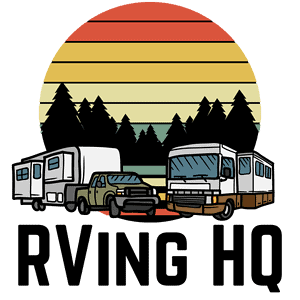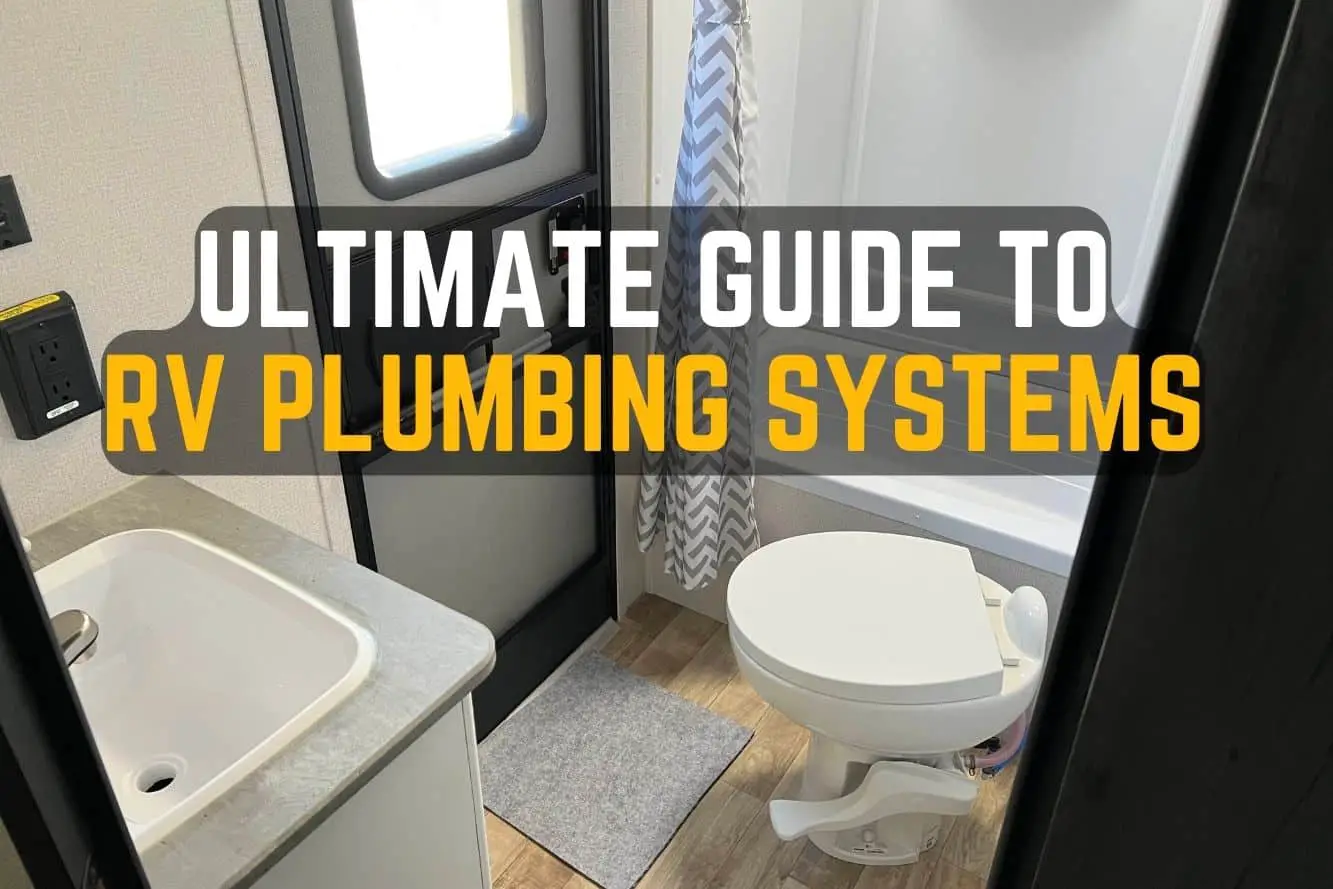RVs can be intimidating, especially if you’re brand new to them. They have so many different systems and it’s all so different from what we’re used to in our homes. Learning it all can feel overwhelming, but RVing Headquarters is here to help! If you want to learn RV plumbing system basics, you’re in the right place.
Not only do we cover the basics and include RV plumbing diagrams, we’ve also got several step-by-step “how-to” tutorials in this post!
This guide covers:
- RV plumbing system basics
- RV holding tanks
- How RV toilets work and how to use them
- How to sanitize your fresh water tank
- How to dump your waste water
- How to find RV dump stations
- Essential RV plumbing accessories
- And so, so much more!
This post contains affiliate links. This means if you make a purchase after clicking a link on our website, we may earn a small commission at no extra cost to you.
Table of Contents
RV Plumbing System Basics
Your RV plumbing system is made up of many of the same components as a house plumbing system, with a major difference: you store your fresh AND waste water on board.
Every self-contained RV will have at least 3 water holding tanks, and the size of the tanks is dependent on the size of the RV. The holding tanks on an RV are:
- Fresh water tank – stores fresh, potable* water for drinking, cleaning, and showering.
- Grey water tank – stores waste water from your sinks and shower.
- Black water tank – stores waste water from your toilets–aka sewage.
*Potable water is water that is safe for human consumption.
Some larger RVs and fifth wheels may have 4 tanks if they have two bathrooms.
These 3 tanks allow you to have all the comforts of home, no matter where you are.
You can use the toilet in your RV, shower in your RV, wash dishes, cook, and yes: you can even drink the water from your RV fresh water tank.
You can fill your RV with fresh water from home, campgrounds, or anywhere with a potable water spigot.
When it’s time to dump your waste water, you need to find an approved RV dump station and connect a sewer hose to dump your RV–we explain all of this later in this post.
Important
RV waste water must always be dumped at an approved dump station. Never dump your RV waste water on the ground. It’s illegal and it’s a biohazard!
Your RV has holding tank sensors on each tank and a panel inside the RV that tells you how full your tanks are so you always know if you need water or if you need to find a dump station.
RV Plumbing System Diagram: An Overview
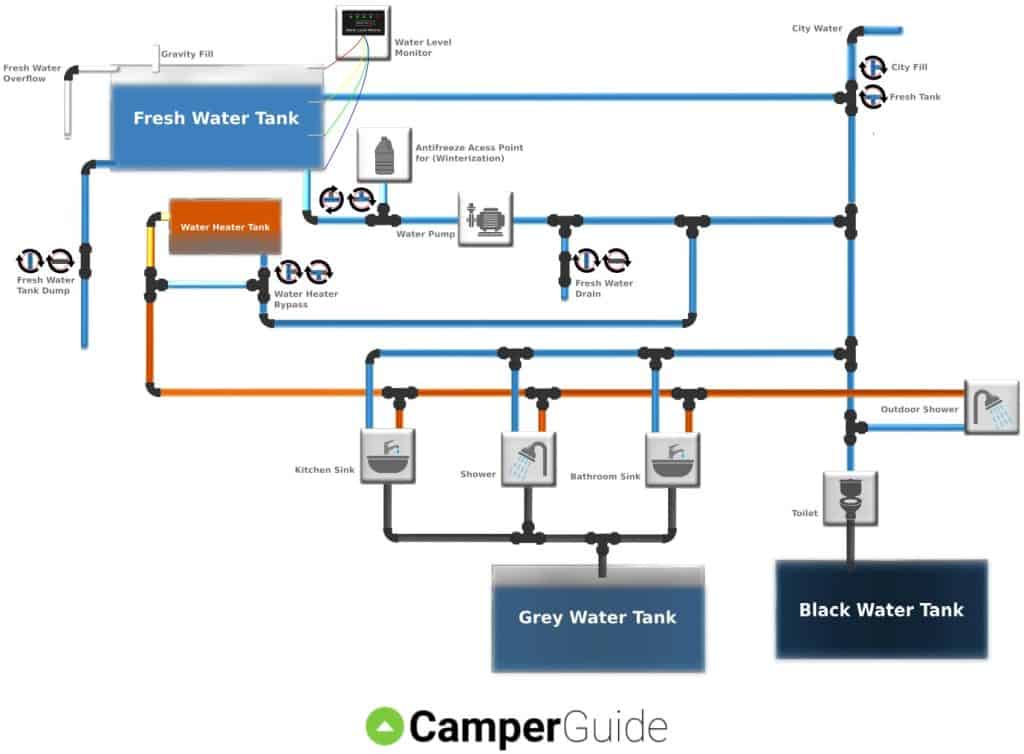
Water-Using Appliances and Fixtures in an RV
Every self contained RV will have these fixtures and appliances at minimum:
- Sink(s)
- Toilet(s)
- Hot water heater
- Water pump
The bigger and more luxurious an RV you have, the more water-using appliances and fixtures you will have. These include:
- Shower(s) – indoor and outdoor
- Washing machine
- Dishwasher
- Ice maker
RV Holding Tanks Explained
To understand RV plumbing system basics, you need to understand RV holding tanks. There are 3 types of holding tanks in every self-contained RV, and each type of tank holds a different kind of water.
Although larger RV types may have more than 3 tanks total, there are only 3 kinds.
Fresh Water Tank
The fresh water tank holds fresh, potable water. You can use this water for drinking, showering, cooking, and washing dishes.
The fresh water tank supplies water to every water-using appliance in your RV. This tank has a filling port on the RV exterior called the city water connection.
“City Water” can mean potable water from any potable source, like from your house spigot, a campground, etc.
Depending on the size of your RV, your fresh water holding tank may be able to hold anywhere from 12 – 100 gallons of fresh water.
Grey Water Tank
“Grey water” is the term used to describe waste water from your sinks, showering, dishwasher, and washing machines. This waste water contains soaps, washing chemicals, and even food particles from washing dishes. Grey water is not true sewage, but it can definitely develop a terrible odor!
Typically, the grey water tank on your RV is as big as (or bigger) than your RV fresh water tank. The grey water tank also fills up the fastest and needs dumped more often.
This tank is plumbed to the grey tank waste valve on the exterior of your RV for dumping.
Black Water Tank
“Black water” is the term used to describe sewage, so your black water tank is your sewage tank. The black tank holds waste and waste water from your toilets, and occasionally your bathroom sink.
If your RV has two bathrooms on either end of the RV, you will likely have 2 black tanks. This is because the black tank is always directly beneath the toilet. This allows solid waste and paper to drop straight from the toilet into the black tank, so you never have to worry about toilet clogs (unless you develop a poop pyramid).
The black tank is plumbed to the black tank waste valve on the exterior of your RV for dumping, located right next to the gray tank waste valve.
RV Holding Tank Diagram
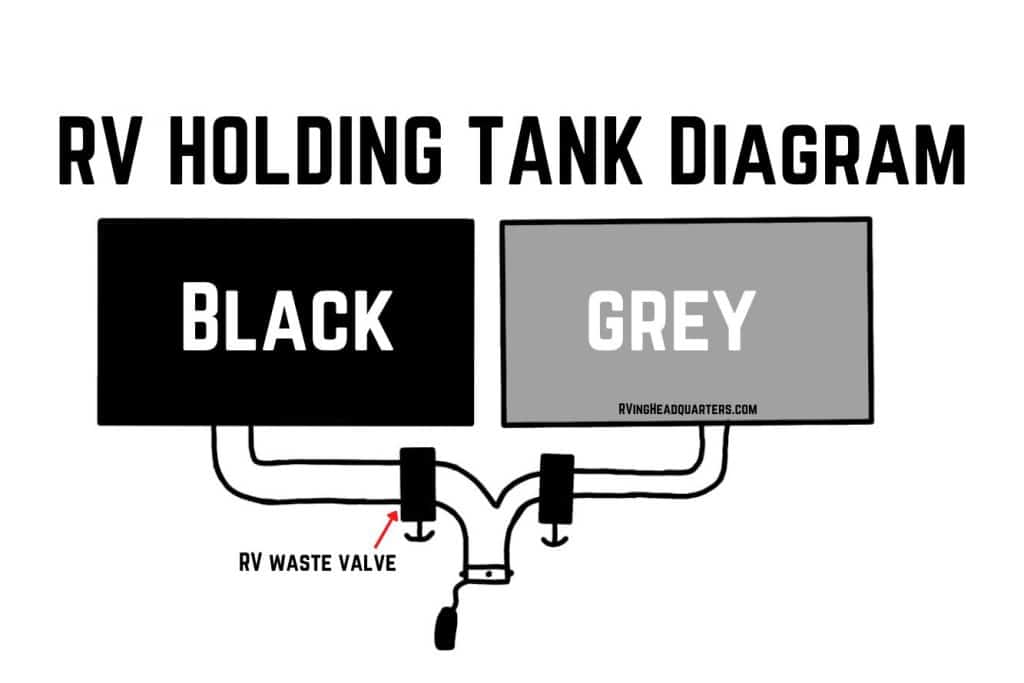
The RV Toilet Explained & RV Toilet Diagram
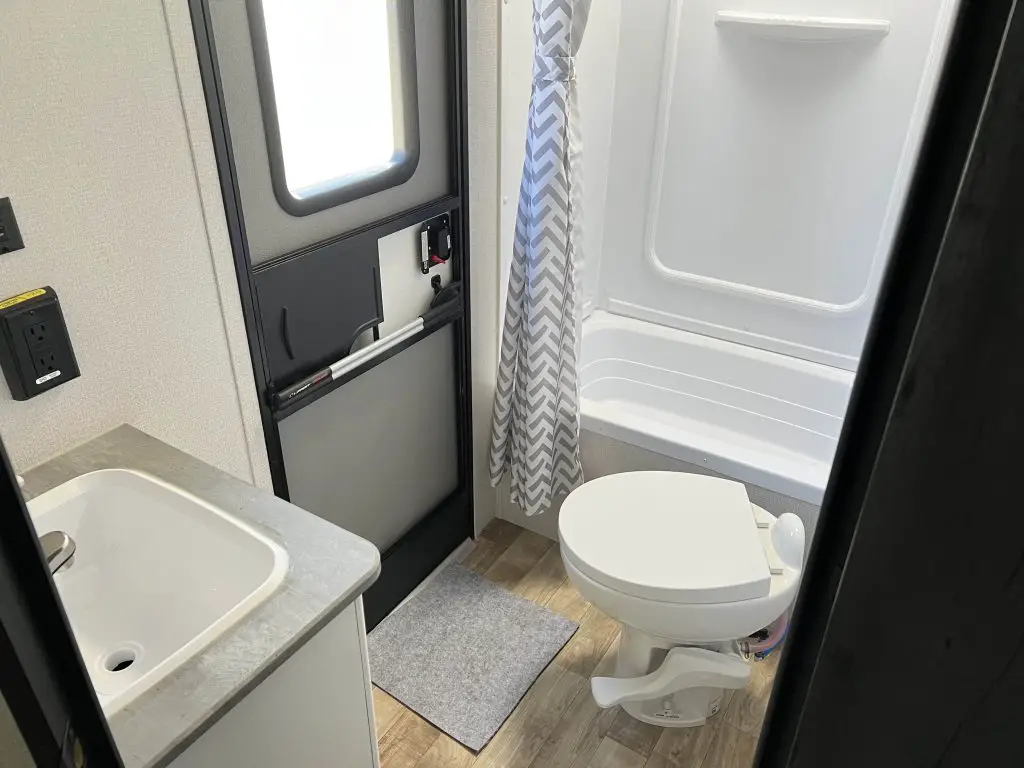
If you’ve ever stepped foot in an RV bathroom, you probably noticed that RV toilets are nothing like residential toilets.
They have a flap that closes the hole, and a pedal on the exterior of the toilet. They don’t have a fresh water holding tank and they also look quite a bit different from a residential toilet. Some RV toilets even have a sprayer or spraying wand for rinsing the bowl.
So how does an RV toilet work?
How Your RV Toilet Works
There are 3 things that make the RV toilet work:
- Water
- The flap
- The pedal
An RV toilet doesn’t have a freshwater tank, but it is hooked up to a water line which you can usually see on the back of the toilet.
The RV toilet pedal works to open the flap and flush the toilet, but it also serves two purposes.
If you hold the pedal down halfway, it fills the toilet bowl with water but doesn’t open the flap.
If you press the pedal all the way, it opens the flap AND activates the water.
The flap in the bottom of the toilet bowl is lined with a rubber gasket, called the flush seal. This rubber gasket serves two purposes: it holds water in the toilet bowl, and it also creates an air-tight seal to prevent odors from the black tank from entering the RV.
RV Toilet Diagram

How to Use an RV Toilet
You can use your RV toilet for both #1s and #2s, but the process is a little different for each.
To use an RV toilet, first hold down the pedal halfway to add some water to the toilet bowl. If you’re going #2, be sure there is plenty of water in the bowl.
To flush, depress the pedal all the way. Hold the pedal down long enough to flush all debris out of the toilet bowl and rinse it.
If you go #2 or you use toilet paper, hold the pedal down for several seconds to flush with plenty of water.
The key to preventing RV black tank clogs is making sure you always have plenty of water in the tank to help liquify solid waste.
This information is for a standard RV toilet which is the most common, but there are many other RV toilet types. Examples include the composting toilet, cassette toilet, macerating toilet, and more.
IMPORTANT RV TOILET TIP: How to Avoid RV Black Tank Clogs
RV black tank clogs are something no one wants to deal with, but they happen often. One of them is the dreaded RV poop pyramid that happens when solid waste and paper build up and create a literal pyramid in the tank.
Here are 4 important tips to prevent RV black tank clogs (essential RV plumbing system basics tips).
- Always flush with plenty of water.
- Use RV-specific toilet paper in your RV toilet, or don’t flush your paper and put it in a trash can instead.
- NEVER leave your black tank waste valve open, even at a full hook-up campground. This causes poop pyramids by allowing liquids to drain and solids will build up. Leave it closed until the tank is full and ready to dump.
- Use a black tank treatment like RV Digest-It to help dissolve solid waste. 2oz treats a 40 gallon tank, add it in after you dump and rinse your tank. This will prevent dried waste from accumulating in your black tank.
RV Plumbing System Inputs and Outputs
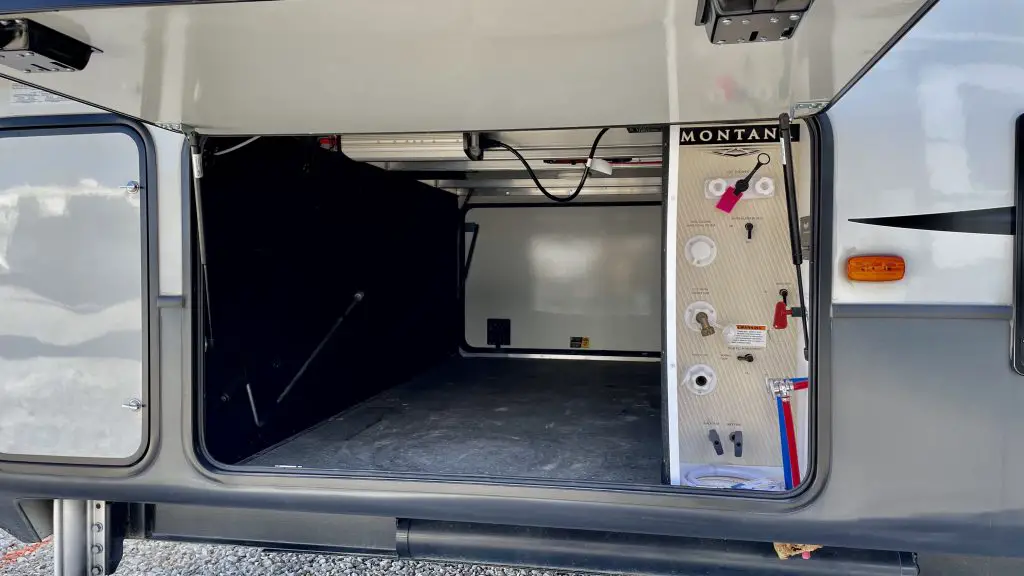
So how does fresh water go IN your RV, and waste water go OUT?
City Water Connection/Fresh Water Fill
Fresh water goes into your RV via the city water connection, which is a port on the exterior of your RV that you hook a hose up to.
Never use a regular garden hose to add fresh water to your RV–you need a potable water hose. Potable water hoses are made specifically for clean drinking water and are free of the chemicals that can leach into the water that you find in garden hoses.
IMPORTANT
Never use your potable water hose for anything other than drinking water. You can use a utility hose for everything else! Store your potable water hose in its own separate and SANITARY container. You never want to risk cross-contaminating!
RV Waste Valves

RV waste valves are exactly what they sound like: valves that open to dump your RV waste water.
Your RV fresh water fill and RV waste valves are both located on the driver’s side exterior of your RV.
In many cases, they are all located in the same general area. Some RVs have a sanitation-station area located in a storage bay, but others have them exposed.
The gray water and black water waste valves will usually look just like handles attached to a metal rod. Pulling these handles will open a valve, called a gate valve, that dumps your RV waste water tanks.
These valves have a rubber gasket, similar to the one on your toilet flap. This keeps them closed and watertight, but they can fail from time to time. If you notice waste water dripping from this area, you may need to replace your gate valve.
IMPORTANT
Never pull your gate valve handle until you are absolutely sure that your RV sewer hose is tightly connected and securely attached to a dump station.
Once you pull the valve to dump your tanks, water comes out with such force that the hose can easily pop off or come out of the sewer port on the ground.
Editor’s Note: The sewer hose popping off mid-dump has happened to me more than once and it’s a disgusting mess! Now I am always sure to tug on my sewer hose at the connection after I hook it up to make sure it’s secure.
How to Fill Your RV Fresh Water Tank
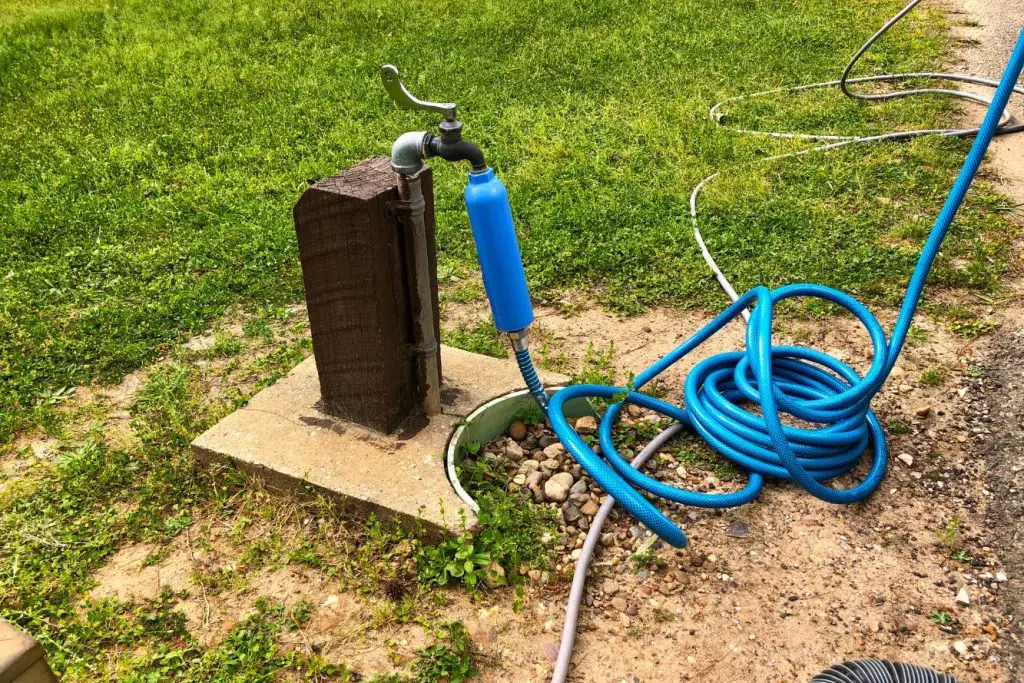
One of the easiest RV plumbing system basics is filling your fresh water tank. Filling your fresh water tank is as simple as hooking up your potable water hose to a spigot, connecting it to your RV, and turning on your “Fresh Tank Fill”.
The fresh tank fill may be labeled differently on different RVs, but it should say something similar.
On most RVs, it’s a knob that can point in one of two directions: city water or fresh tank fill.
Leaving the knob on “City Water” does not fill your fresh water tank. This simply allows the water from the spigot to go directly to your taps and appliances any time you use them. This is a good option if you are staying in one spot for a long period of time, as long as the temps are above freezing.
Turning the knob to “Fresh Water Fill” will allow the water to go through your RV plumbing and fill up your fresh tank. Be sure to constantly monitor your tank monitoring panel so you can turn the water off before your fresh water tank overflows.
Can You Drink Water From Your RV?
Yes! You can drink water from your RV, as long as you keep up on your fresh water tank sanitization maintenance. Your RV is meant to be a home-away-from-home, and it’s meant to have every creature comfort as a house.
If you regularly sanitize your fresh water tank, the water in your RV can be used for drinking, bathing, washing dishes, and cooking!
Sanitizing Your RV Fresh Water Tank – RV Plumbing System Basics
You should sanitize your RV fresh water tank every 6 months if you’re a full-time RVer, or before every camping season if you’re a part-time RVer.
Sanitizing your RV water tank is a pretty simple procedure. It involves adding chlorinated water to your fresh water tank and running it through all your faucets. Then, let it sit for several hours, drain it out, and run fresh water through your system.
Important: Never add undiluted bleach to your RV plumbing system. This will damage your tank and pipes! Always be sure to mix bleach with plenty of water and have a few gallons of water already in your tank before adding the bleach mixture.
You’ll need about ½ cup of bleach for every 25 gallons of fresh water. Mix your required amount of bleach with several gallons of fresh water before adding to your RV tank.
- Drain your RV fresh water system including all faucets, toilet, shower, etc.
- Turn off and bypass your hot water heater and any other appliance you don’t want bleach to get in. There are knobs to do this, refer to your owners manual if necessary.
- Mix your bleach with several gallons of fresh water.
- Add bleach water to your RV fresh water system.
- Fill fresh water tank.
- Turn on your water pump and open all faucets one by one until you smell the bleach water mixture.
- Let sit for 6-12 hours.
- Drain your fresh water tank and refill.
- Run fresh water through all your faucets (one-by-one) until you no longer smell bleach, and you’re done!
How and Where to Dump Your RV Waste Water
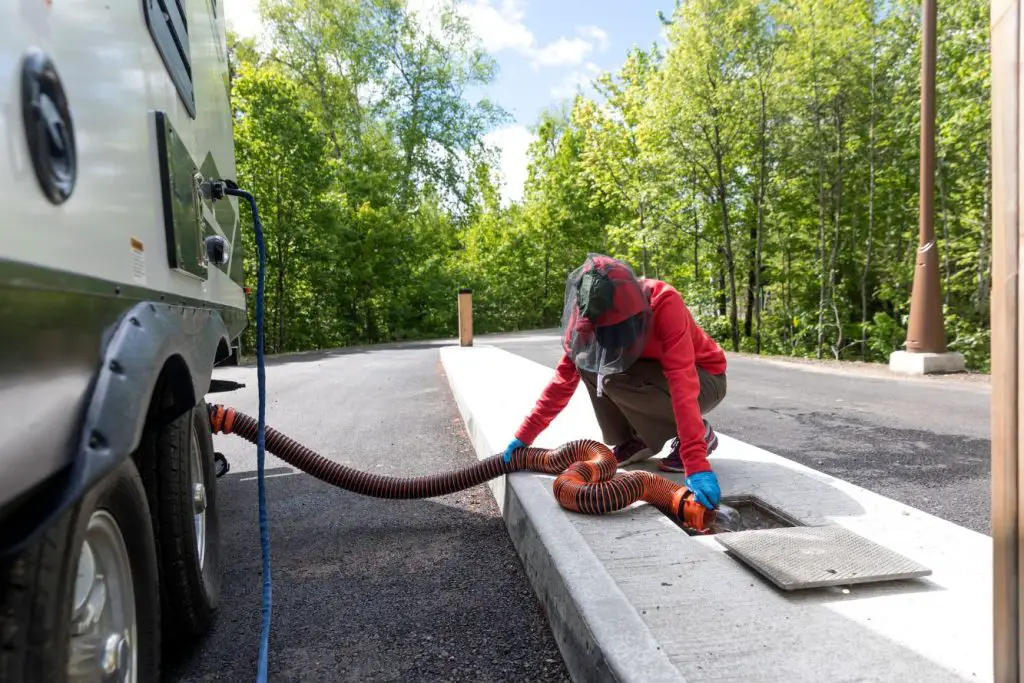
To dump your RV waste water, you need:
- An RV sewer hose kit with a clear attachment
- Gloves
- Clorox wipes
- Utility hose
- A dump station!
The quality of your accessories will make all the difference when doing this dirty job.
Not all RV sewer hoses are made the same, and some can make the job a lot harder, messier, and more disgusting than others.
Editor’s Note: I tried the cheap, flimsy RV sewer hoses ONE TIME and vowed I would never go back! It was an awful experience, the sewer hose slithered around like a snake and the attachments were impossible to screw on.
Now, I use the Rhino Extreme sewer hose kit (shown in photo above) because it’s rigid and stays in place. It’s a bit pricey, but I promise you it’s worth it… I’ll never use another brand!
Most RVers recommend having a clear attachment so you can see the color of the water draining as you rinse out your tanks. It might seem gross, but it’s a fact of life and it’s the only way you can know if your tanks are actually clean! (The Rhino kit comes with one, so no worries on that.)
How to Dump Your RV Waste Tanks – RV Plumbing System Basics
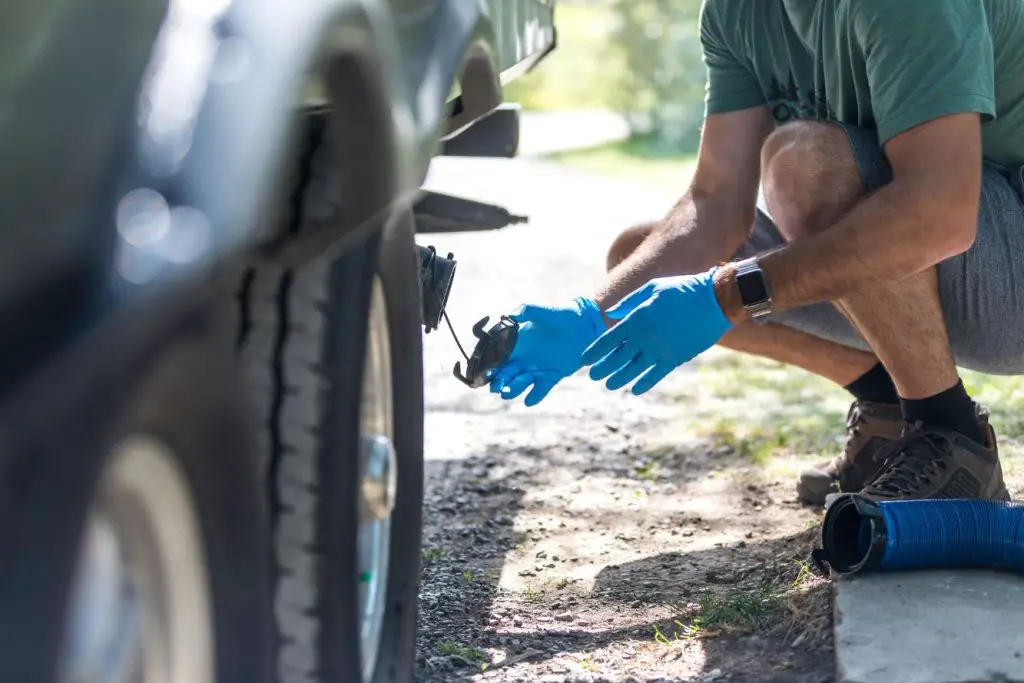
RVHQ Tip: always dump your black tank first. Dumping your grey tank after your black tank helps rinse out the sewer hose and remove any remaining sewage or debris.
- Put on gloves.
- Hook up your RV sewer hose to your RV sewer hose hookup, and give it a good tug or jiggle to make sure it’s locked in place.
- Put the other end of the sewer hose into the dump port on the ground. Be sure this is secure in the hole. Sometimes there will be a large rock or cement block to put on the top of the hose to hold it in place.
- Once you’re sure everything is tight and secure, slowly start to open the black tank valve. If the hose is remaining tight and secure, you can open the waste valve all the way.
- Once the black tank is empty, close the valve.
- Hook up your utility hose to your black tank flush (if applicable) and flush your black tank for 10-15 minutes, then drain again and close the valve.
- Repeat the process with your grey tank, then close the grey tank valve.
- Remove your sewer hose from your RV but leave it in the dump port.
- Use your utility hose to rinse out your RV sewer hose.
- Put your sewer hose and utility hose away.
- Use sanitizing wipes to wipe down the spigot and all valves and handles on your RV that you touched during the process.
How to Find RV Dump Stations Near You
Dumping RV waste water is just a fact of life, and you can find RV dump stations all over the place.
By law, you cannot dump RV waste water on the ground. Both grey water and black water should only ever be disposed of in an approved RV dump station.
RV dump stations can be found:
- At your campsite if you have full hook-ups.
- At campgrounds, RV parks, state parks, etc.
- At RV dealerships.
- At RV service centers.
- At some gas stations.
- At some rest stops.
Apps and Websites to Find RV Dump Stations:
- Allstays
- Allstays RV Dumps App
- Sanidumps
- FreeRoam App
- RV Dump Stations App
- Campendium
Essential RV Plumbing System Accessories
We say “essential” because these accessories really are essential in some way or another. For example, you can’t dump your RV waste water without a sewer hose.
And, in some campgrounds, you’re not allowed to hookup to the sewer unless you have a sewer donut and/or a sewer hose support.
Each of these essential accessories has a link to a recommended product on Amazon and a brief description of why you need it.
Important: RVers should carry two hoses. You need a potable water hose AND a utility hose. Your utility hose can be a garden hose, and you can use this hose for everything from rinsing your feet to washing your RV or rinsing your sewer accessories. NEVER store your utility hose and potable hose together.
- Water Filter – A water filter is essential for filtering out sediment from varying water sources. Some campgrounds have a lot of sediment in the water that can damage your RV plumbing.
- Water Pressure Regulator – Campgrounds do not regulate their water pressure, but your RV can only handle 40-60 PSI. Some campgrounds have 100+ PSI and can rupture your RV pipes.
- RV Sewer Hose and Clear Attachment – This is essential for dumping your tanks.
- RV Sewer Donut – This is a sewer port attachment that helps your sewer hose stay in securely. Some campgrounds require this.
- RV Sewer Hose Support – This keeps your RV up off the ground and provides a slope for draining. Required by some campgrounds and RV parks.
- Extra RV Waste Valves – Essential to have if one of your waste valves fails and starts leaking.
- Potable Water Hose – For drinking water only. Be sure to get a potable hose that’s rated specifically for drinking water.
- Utility Hose – For everything else.
Storing Your RV Plumbing Accessories
Always store your fresh water supplies in a sanitary container that’s watertight and never cross-contaminated with other things.
Editor’s Note: I like to use clear plastic totes to organize my sewer accessories and I label the exterior so I never mix them up.
All of my fresh water supplies like fresh water hose, water filters, and water pressure regulator all go in one tote. I keep this tote clean and dry and I clean it with a bleach water spray bottle mixture every few months to keep it sanitized.
All my sewer supplies go in a designated sewer tote that I store away from my fresh water tote. If you have to store them together, store your sewer tote on the bottom.
Wrapping Up RV Plumbing System Basics
This RV Plumbing System Basics is a beast of a guide, and I hope by now you have a solid understanding of how the RV plumbing system works. And how to actually use it, clean it, and dump it!
The RVHQ editors are constantly adding to this post and updating it to keep the information fresh, and adding additional insight when we find it.
